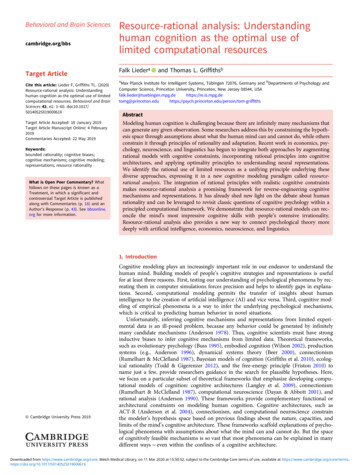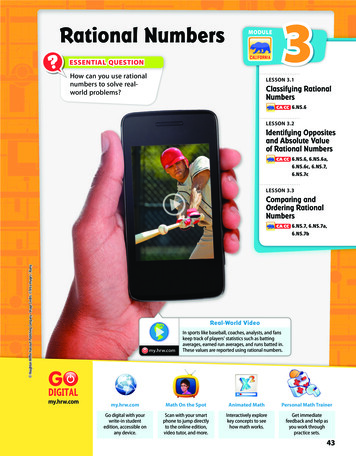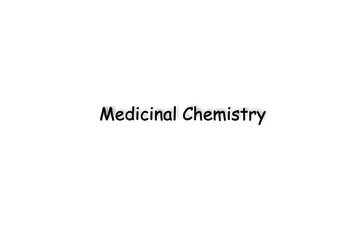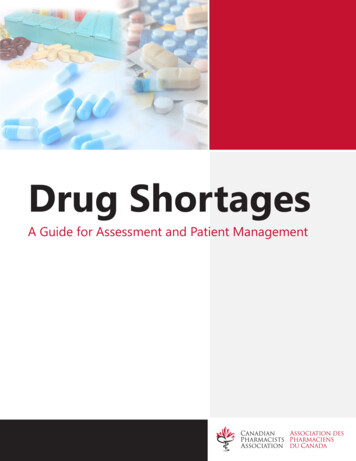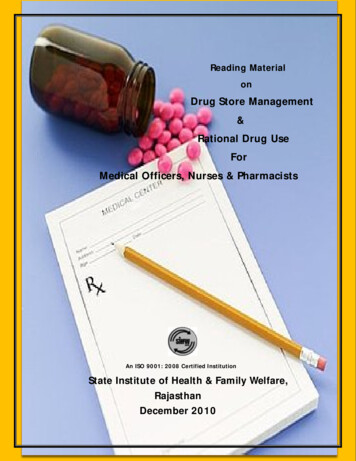
Transcription
SIHFW: an ISO:9001:2008 certif ied institutionDrug Store Management and Rational Drug UseReading MaterialonDrug Store Management&Rational Drug UseForMedical Officers, Nurses & PharmacistsAn ISO 9001: 2008 Certified InstitutionState Institute of Health & Family Welfare,RajasthanDecember 2010i
SIHFW: an ISO:9001:2008 certif ied institutionDrug Store Management and Rational Drug UseIndex1.2.3.4.5.Introduction1a.Some common terms1b.Classification of drugs4Laws, Regulations and Organizations6a.Drug Acts and Regulations6b.National Drug Authority7c.Drug Standard Control Organizations8Rational Use of Drugs11a.Definitions11b.Problem of irrational us e of drugs12c.Promotion of RUD13d.Medication errors14Drug Store Management17a.Drug selection process18b.Procurement of drugs19c.Drug distribution25d.Preparation of drug store26e.Ordering supplies28f.Receiving supplies34g.Organizing supplies and storage36h.Inventory management41i.Record keeping48Handling of Drugs51a.Handling of narc otics/ scheduled drugs51b.Handling of hazardous drugs54c.Handling of expiry drugs56d.Disposal – steps and methods57e.Special handling of flammables and corrosives616.Drug Quality Assurance627.Drug Use in Special Situations648.Antimicrobials-Use and Resistance71ii
SIHFW: an ISO:9001:2008 certif ied institutionDrug Store Management and Rational Drug Use9.Adverse Drug Reactions (ADR)77a.Some common terms77b.ADR – types & severity79c.Monitoring ADR81d.Reporting ADR85e.Drug interactions88f.Recall of drugs9210.Drug Management Information System9411.Waste Management and Infection control100a.BMW management100b.Infection control10412.RMRS11313.Roles and Responsibilities of Pharmacist12114.Roles and Responsibilities of Nursing ii
SIHFW: an ISO:9001:2008 certif ied institutionDrug Store Management and Rational Drug UseChapter 1: IntroductionDrugs & Medicines being expensive and resources limited, it becomes imperative to improve their supply,increase the use, and minimize the cost through a pharmaceutical management system to be effectivelyput in place. There are some 3000-4000 drugs at any point in time, registered in any count ry; of whichalmost 70% are non essential (WHO). Ideally, a National list of essential drugs should have 300-400drugs; a district hospital needs some 150 to 200, while a health centre can manage with 40-50 drugs.Shorter the list, it is easier to manage, procure and offer to the patients within the resources available.In the overall management of drugs, the following objectives have to be borne in mind:1All essential drugs needed for health care should be available at all the times, at all the healthfacilities.2Drugs so made available should be of good quality and should be safe.3Systems of procurement should be such that quality drugs are procured at the mostcompetitive prices.Drugs have always remained and are likely to remain the core element in preventive as well as in curativehealth care. Medicinal drugs inclusive of vaccines, contraceptives, nutritional supplements etc. areindispensable for the prevention, control, treatment and amelioration of a number of maladies that affecthuman beings. Interestingly, pharmaceuticals are the largest item of expenditure within the public healthsector budgets of developing countries, ranging from 8 to 12% of recurrent health budget; thereforeasking for prudence.There are four major areas related to drug management:a) Rational use,b) Affordable price,c) Sustainable financing andd) Reliable health and supply systems.Let us start by learning some common term s and their definitions used in drug management:Medicine:a) An agent, such as a drug, used to treat diseas e or injury.b) Something that serves as a remedy or correctivec) Any drug or remedy for use in treating, preventing, or alleviating the symptoms of diseased) Any substance administered in the treatment of disease; a remedial agent; a remedy; physic.1
SIHFW: an ISO:9001:2008 certif ied institutionDrug Store Management and Rational Drug UseDrug:a) A drug is a chemical substance that affects processes of body and mind.b) Any chemical compound used or administered to humans and/ or animals in the process ofdiagnosis, treatment or prevention for relief of pain or sufferings or to c ontrol or improve aphysiological process or pathological state.c) A substance used recreationally for its effects on Central Nervous System.Generic drugs:The term "generic" has several meanings as regards drugs:1.The chemical name of a drug.2.A term referring to the chemical makeup of a drug rat her t han t o the advertised brand nameunder which the drug is sold.3.A term referring to any drug marketed under its chemical name without advertisingThe use of generic names for these purposes has many advantages, like:1.Easy recognition of type of drugs, particularly when many selected drugs exist in that category(e.g. all Benzodiazepines have generic name ending with “zepam”).2.Drugs can be purchased from multiple suppliers giving the advantage of buying at competitiveprices.3.Product substitution is easy where bioavailability pres ents a problem.4.Confusion with brand names can be avoided.Since chemical names are usually long and complicated, the drugs are given a standard, shorter genericname. Manufacturers will usually give drugs brand names to identify that manufacturer's version of theproduct. An example of thes e three names, using a well known prescription drug is as follows:Chemical name — 7-chloro-1, 3-dihydro-1- methyl-5-phenyl-2H-1, 4-benzodiazepin-2-one;Generic name — diazepamBrand name — Valium.Since the research and development of the drug molec ule has already been done, the cost of the genericdrug is usually less.All drugs considered to be generically equivalent to a brand name product must meet strict manufacturingrequirements. These requirements include t ests which assure that the product is bioequivalent to thebrand name product.Spurious DrugsSpurious drugs a drug shall be deemed to be spurious, ifa) it is imported under a name which belongs to another drug; orb) it is an imitation of or a substitute for, another drug or resembles another drug in a manner likely2
SIHFW: an ISO:9001:2008 certif ied institutionDrug Store Management and Rational Drug Useto deceive or bears upon it or upon its label or contains t he name of another drug unless it isplainly and conspicuously marked so as to reveal its true character and its lack of identity withsuch other drug ; orc) the label or the container bears the name of an individual or company purporting to be themanufacturer of the drug, which individual or company is fictitious or does not exist; ord) it has been substituted wholly or in part by another drug or substance; ore) it purports to be the product of a manufacturer of whom it is not truly a product .Substandard DrugsSubstandard Drugs/ medicines (also c alled out of specification (OOS) products) are genuine medicinesproduced by manufacturers authorized by the Cent ral Drugs Standard Control Organization (CDSCO)which do not meet quality specifications set for them by national standards.Some important term s used according to Drug and Cosmetic Act that one should know in relation toDrugs areStandards of quality meansa) In relation to a drug, that the drug complies with the standard set out in the Second Schedule,b) In relation to a cosmetic, that the cosmetic compiles with such standard as may be prescribed.Misbranded drugs - a drug shall be deemed to be misbrandeda) if it is so colored, coated, powdered or polished that damage is concealed or if it is made toappear of better or greater therapeutic value than it really is; orb) if it is not labeled in the prescribed manner; orc) if its label or container or anything accompanying the drug bears any statement, design or devicewhich makes any false claim for the drug or which is false or misleading in any particular;Adulterated drugs a drug shall be deemed to be adulterateda) if it consists, in whole or in part, of any filthy, putrid or dec ompos ed substance; orb) if it has been prepared, packed or stored under insanitary conditions whereby it may have beencontaminated wit h filth or whereby it may have been rendered injurious to health; orc) if its container is composed in whole or in part, of any poisonous or deleterious substance whichmay render the contents injurious to health; ord) if it bears or contains, for purposes of coloring only, a color other than one which is prescribed; ore) if it contains any harmful or toxic substance which may render it injurious to health; orf)if any substance has been mixed therewith so as to reduce its quality or strength.3
SIHFW: an ISO:9001:2008 certif ied institutionDrug Store Management and Rational Drug UseClasse s of drugs:The two main classes of drugs are: (1) non-pre scription drugs, and (2) pre scription drugs.Non-Pre scription drugs are commonly called over-t he-c ounter, or OTC drugs, and can be boughtwithout a prescription.Prescription drugs (or legend drugs) are drugs that require a prescription because they are consideredto be pot entially harmful if not used under the supervision of a licensed health care practitioner. Certainprescription drugs have additional controls placed upon them. These drugs are called controlled (orscheduled) drugs.Drug cla ssification according to schedules:Controlled DrugsA controlled (scheduled) drug is one whose use and distribution is tightly controlled becaus e of its abusepotential or risk. The drugs with t he highest abuse potential are placed in Schedule I, and those with thelowest abuse potential are in Schedule V. These schedules are commonly shown as C-I, C-II, C-III, C-IV,and C-V. Some examples of drugs in these Schedules are as follows:Schedule I –Drugs with a high abuse risk. These drugs have no safe, accepted medical use. Someexamples are heroin, marijuana, LSD, PCP, and crack cocaine.Schedule II –Drugs with a high abuse risk, but also have s afe and accepted medical uses. These drugscan cause severe psychological or physical dependenc e. It includes certain narcotic,stimulant, and depressant drugs. Some examples are morphine, cocaine, oxycodone.Schedule III, IV, or V –Drugs with an abuse risk less than Schedule II. These drugs also have safe and acceptedmedical uses. Schedule III, IV, or V drugs include those containing smaller amounts ofcertain narcotic and non-narcotic drugs, anti-anxiety drugs, tranquilizers, sedatives,stimulants and non-narcotic analgesics. Some examples are acetaminophen with codeine.Other classi fications:Schedule G:Details of drugs to be labeled with words “Caution – it is dangerous to take this preparationexcept under medical supervision” e.g., aminopterin, insulin, metformin, promethazine etc.Schedule H:Deals wit h drugs and medicines, which must be sold by retail only when a prescription byregistered medical practitioner is produced e.g., capt opril, atenolol, allopurinol, haloperidol,norfloxacin, etc.4
SIHFW: an ISO:9001:2008 certif ied institutionDrug Store Management and Rational Drug UseSchedule J:Disease and aliment (by whatever name described), which a drug may not purport toprevent or cure e.g., appendicitis, blindness, blood poisoning, blood pressure (high or low),etc.Schedule N:Deals with minimum equipment of a pharmacy and gives direction regarding (a) entrance ofa pharmacy; (b) premises; (c) furniture and apparatus; (d) general provisions,Schedule P:Defines life period of drugs (shelf life), the period up to which the drug will remain stableunder the storage conditions from the date of manufacture;Schedule W:List of drugs that are to be marketed under generic name only.Schedule X:Gives name of psychotropic drugs, requiring s pecial license for manufacture and sale e. g.alprazolam, amfepramone, barbital, benzphetamine, clobazam, clonazepam, clorazepat e,etc.5
SIHFW: an ISO:9001:2008 certif ied institutionDrug Store Management and Rational Drug UseChapter 2: Laws, Regulations and OrganizationsDrug Acts & Regulations: Hi storical PerspectiveThe Poisons Act and the Dangerous Drugs Act were passed in India in 1919 and 1930 respectively. Thenin 1931, Indian Government appoint ed a Drugs Enquiry Committee under the Chairmanship Lt. Col. R. N.Chopra which was asked to make sifting enquiries int o the whole matter of drug production, distributionand sale by inviting opinions and meeting concerned people. The Committee recommended theestablishment of a well-equipped Central Drugs Laboratory for an efficient and speedy working of thecontrolling department; the permission of Central P harmacy Council, and the P rovincial P harmacyCouncils.However, the Drugs Act was passed in 1940 partly implementing the Chopra recommendations. With theachievement of independence in 1947 the rest of the required laws were put on the Statute B ook. In1985, the Narcotic Drugs and Psychotropic Substances Act were enacted repealing the Dangerous DrugsAct 1930 and the Opium Act of 1878.The Drugs and Cosmetics Act, 1940 (amended 2008) and The Drugs and Cosmetics Rules, 1945:The object of the Act is to regulate the import, manufacture, distribution and s ale of drugs.Under the provisions of this Act, the Central Government appoints the Drugs Technical A dvisory Board toadvis e the Central Government and the State Governments on technical matters arising out of theadministration of this Act.The Act was amended many times in public interest, the last being in the year 2008 which focused onmaking the Act stricter in terms of imprisonment and penalties.Pharmacy Act, 1948 (amended 1984)The Act aims to regulate the profession of Pharmacy in India. Under the provisions of this act the CentralGovernment constitutes a Central Pharmacy Council of India. The Central Council can approvequalifications granted by an outside authority for qualifying for registration under this Act.The Drugs (Control) Act, 1950An Act to provide for the control of the sale, supply and distribution of drugs and also provide guidelinesfor fixing of maximum prices and maximum quantities which may be held or sold, marking of prices andexhibiting list of pric es and stocks, obligation to state price separat ely on composite offer, prohibition orregulation of the disposal of drugs, penalties and offences by corporations.6
SIHFW: an ISO:9001:2008 certif ied institutionDrug Store Management and Rational Drug UseThe Narcotic Drugs and Psychotropic Substance s Act, 1985This is an Act to consolidate and amend the law relating to Narcotic Drugs, to make stringent provisionsfor the control and regulation of operations relating to Narcotic Drugs and Psychotropic Substances.Drug Policy, 1986 (revi sed 1994)The drug Policy was framed with the main objectives of ensuring abundant availability, at reasonableprices, of essential life saving and prophylactic medicines of good quality; strengthening t he system ofquality control over drug production and promoting the rational use of drugs in the country; creating anenvironment conducive to channelizing new investment into the pharmaceutical industry, to encouragingcost-effective production with economic sizes and to introducing new tec hnologies and new drugs, andstrengthening the indigenous capability for production of drugs.Pharmaceutical Policy, 2002The c hange in nomenclature from ‘Drugs Policy’ to ‘P harmaceutical Policy’ may empower the Ministry ofChemicals and Fertilizers to bring under their domain some more activities logically placed, for thepresent under the Ministry of Health & Family Welfare. Policy has kept minimum number of drugs underthe price cont rol and has also abolished industrial license system.National Drug AuthorityIn view of the P harmaceutical Policy, it is envisaged t hat a National Drug Authority may be set up by aseparate Act of Parliament to perform the following functions:1.Develop and define basic appropriate standards relating to the manufacture, import, supply,promotion and use of drugs.2.To approve and register pharmaceutical products for use in the country only ifa) it meets real medical needs,b) it is therapeutically effective, andc) it is acceptable and safe3.To enforc e effectively appropriate quality standards of medicines and good manufacturingpractices, throughout the country, having full regard to the needs of public health and standardizedosage strengths and pack sizes of formulations with a view to check proliferation.4.To monitor standard practices in drug promotion and use and to clearly identify those which areacceptable and prohibit those which are unethical and against the consumer int erest.5.To monitor the prescribing practices and to evaluate their appropriateness for the purpose ofguiding the medical profession and for achieving the aim of rational prescribing.6.To ensure that appropriate information about registered pharmaceuticals is made available forthe guidance of cons umers having regard to:7
SIHFW: an ISO:9001:2008 certif ied institutionDrug Store Management and Rational Drug Usea) the adverse consequences of non-compliance by patients particularly in the case ofantibiotics, steroids etc.,b) dangers of self-medication, andc) the need to involve consumers as full part ners in the healt h care system .7.To prepare and publish a national formulary and formularies relevant to various levels (like districthospital, community cent re, primary health centre) for the guidance of consumers as well asdoctors.Drug Standard Control OrganizationsCentral Drug Standard Control OrganizationThe Cent ral Drugs Standard Control Organization (CDS CO) is headed by the Drugs Cont roller General(India) (DCGI) which discharges the functions allocated to Central Government by the Drugs andCosmetics Act. The CDSCO is attached to the office of the Director General of Health S ervices in theMinistry of Health and Family Welfare. The DCGI is a statutory authority under t he Act and has portoffices, zonal offices wit h drug inspectors and drug testing laboratories functioning under him.Statutory functions of CDSCO:a) Laying down standards of drugs, cosmetics, diagnostics and devices.b) Laying down regulatory measures, amendments to Acts and Rules.c) To regulate market aut horiz ation of new drugs.d) To regulate clinical research in India.e) To approve licenses to manufacture certain categories of drugs as Central Licence A pprovingAuthority i.e. for blood banks, large volume parenterals and vaccines & sera.f)To regulate the standards of imported drugs.g) Work relating to the Drugs Technical A dvisory Board (DTAB) and Drugs Consultative Committee(DCC).h) Testing of drugs by Central Drugs Labsi)Publication of Indian PharmacopoeiaOther functions:a) Coordinating the activities of the State Drugs Control Organizations to achieve uniformadministration of the Act; and policy guidanceb) Guidance on technical mattersc) Participation in the WHO GMP certification scheme.d) Monitoring adverse drug reactions (ADR).e) Conducting training programs for regulatory officials & Govt. Analysts8
SIHFW: an ISO:9001:2008 certif ied institutionDrug Store Management and Rational Drug Usef)Distribution of quotas of narcotic drugs for use in medicinal formulationsg) Screening of drug formulations available in Indian marketh) E valuation/Screening of applications for granting No Objection Certificat es for export ofunapproved/ banned drugs.CDS CO – OrganogramDirectorate General of Health ServicesCentral Drugs Standard Control OrganizationDrugs Controller General (India)Head QuarterØ Jt. Drugs Controller (I)Ø Dy. Drugs ControllerØØØØ(I)Asstt. DrugsController (I)Technical OfficerSr. Tech. Asstt.Supporting StaffZonal Offices (4)Ø Dy. DrugsØØØØController (I)Asstt. DrugsController (I)DrugsinspectorSr. Tech. Asstt.SupportingStaffSubzonal Offices (3)Port/ AirportOffice (7)Ø Asstt. DrugsØ Asstt.Controller (I)Ø Technical AssttØ Sr. Tech. Asstt.Ø Supporting StaffDrugsController(I)Ø TechnicalOfficerØ Sr. Tech.Asstt.Ø SupportingStaffLaboratories (6)Ø DirectorØ Dy. DirectorØ Sr.ØØØØNorth Zone: GhaziabadSouth Zone: ChennaiEast Zone: KolkataWest Zone: MumbaiØAhmedabadHyderabadAhmedabad,Chennai, Delhi,Kochi, KolkataNharasev a,MumbaiScientificOfficer (I)Sr.ScientificOfficer cAsstt.SupportingStaffCDL :, Kolkata*Not underCDSCOCIPL, Ghaziabad** To start shortlyCDPL, MumbaiCDTL, ChennaiRDTL, Guw ahati*CDL, Kasauli* IVRI,*NIB, Noida9**RDTL,Chandigarh
SIHFW: an ISO:9001:2008 certif ied institutionDrug Store Management and Rational Drug UseState Drugs Control Organizations:The State Drugs Control Organization was set up in the state to implement the provisions of the Drugsand Cosmetics Act, 1940 and its subsequent amendments.The major functions of the organization are:a) Licensing of drug manufacturing and sales establishments.b) Licensing of drug testing laborat oriesc) Approval of drug formulations for manufactured) Monitoring of quality of Drugs & Cosmetics, manufactured by res pective state units and thosemarketed in the state.e) Investigation and prosecution in respect of contravention of legal provisionsf)Administrative actionsg) Pre- and post- licensing inspectionh) Recall of sub-standard drugsState Drugs Control Organization – OrganogramDrugs Controller(2)(State Level)Assistant Drug Controller(17)(State Level)Drugs Control Officer (45)(District Level)10
SIHFW: an ISO:9001:2008 certif ied institutionDrug Store Management and Rational Drug UseChapter 3: Rational Drug useMedically inappropriat e, ineffective and economically inefficient use of pharmaceuticals is commonlyobserved in health care systems at the level of decision making and delivery of services, throughout theworld, especially in developing countries. The costs of such irrational drug use are enormous in terms ofboth scarce resources and the adverse clinical consequences of therapies that may have real risks but noobjective benefits.Obviously, this should also become the concern of all t he stake holders, practitioners, pharmacists andnurses.Defining Rational Use of DrugsThe concept of rational drug use is age old, as evident by the statement made by the Alexandrianphysician Herophilus 300 B. C that is “Medicines are nothing in themselves but are the very hands of godif employed with reason & prudence.”Rational use of drugs requires that patients receive medicines appropriate to their clinical needs, in dosesthat meet their own individual requirements, for an adequate period of time, and at the lowest cost tothem and their community. (WHO Conference on Rational Use of Drugs in Nairobi in 1985).In simplest words rational use means“prescribing right drug, in adequate dose for the sufficient duration & appropriate to the clinical needs ofthe patient at lowest cost”.The requirements for rational use will be fulfilled if the proc ess of prescribing is appropriately followed.This process includes steps like1.Defining a patient’s problems (or diagnosis);2.Effective and safe treatments (drugs and non drugs);3.Selecting appropriate drugs, dosage, and duration;4.Writing a prescription;5.Giving patients adequat e information; and6.Planning to evaluate treatment respons es.Unfortunately, in the real world, prescribing patterns do not always conform to these steps and can beclassified as inappropriate, irrational or pathological prescribing.11
SIHFW: an ISO:9001:2008 certif ied institutionDrug Store Management and Rational Drug UseCommon pattern of irrational prescribinga) The use of drugs when no drug therapy is indic ated, e.g., antibiotics for viral upper respiratoryinfections.b) The use of the wrong drug for a specific condition requiring drug therapy, e.g., antibiotics inchildhood diarrhea requiring ORS.c) The use of drugs with doubt ful or unproven efficacy, e.g., the use of antimotility agents in acutediarrhea.d) A vailable, safe, and effective drugs.e) The use of correct drugs with incorrect administration, dos ages, and duration, e.g., metronidazolevs. albendazole.f)Indiscriminate us e of injections, e.g., in malaria treatment (for ignorance/ pressure from patients).g) Multiple or over-prescription (t he use of a third generation antimicrobial) for treating minor A RI,anti-diarrheal for nonspecific childhood diarrhea and multivitamins and tonics for malnutrition.h) Under-use of effective drugs in conditions for which effective medicines exist. (hypertension,depression, and anemia during pregnancy).Problem of Irrational Use of DrugsFactors underlying irrational use of drugs1.Patientsa) drug misinformationb) misleading beliefsc) patient demands/expectations2.Prescribersa) lack of education and trainingb) inappropriate role modelsc) lack of objective drug informationd) generalization of limited experiencee) misleading beliefs about drugs efficacyf)less consultation timeg) poor communication between health professional and patienth) profit driven attitude3.Workplacea) heavy patient loadb) pressure to prescribec) lack of adequate lab capacityd) insufficient staffing12
SIHFW: an ISO:9001:2008 certif ied institutionDrug Store Management and Rational Drug Use4.Drug Supply Systema) unreliable suppliersb) drug shortagesc) expired drugs suppliedd) less dispensing timee) profit driven attitude5.Drug Regulationa) nonessential drugs availableb) informal prescribersc) lack of regulation enforcement6.Industrya) lucrative promotional activitiesb) misleading claimsc) lack of diagnostic facilities and uncertainty of diagnosisVarious causes that lead to the realiz ation of irrational drug use included the increase in number of drugsavailable and thus complicating the choice of appropriate drug for particular indication, development ofresistance to highly efficacious & life saving new antimicrobial drugs, increased cost of the t reatment andextension of Consumer Protection Act in medical profession to restrict the irrational use of drugs.Impact of Inappropriate Use of DrugsThe impact of this irrational use of drugs can be seen in many ways:1.Reduction in the quality of drug therapy leading to increased morbidity and mort ality andconsequent drug resistance.2.Waste of resources leading to reduced availability of other vit al drugs and increased costs ofhealth care.3.Increased risk of unwanted effects such as adverse drug reactions and the emergence of drugresistance, e.g., malaria and Multiple Drug Resistant Tuberculosis.4.Psychosocial impacts, such as when patients come to believe that there is “a pill for every ill”leading to increased drug demand.Measure s To Promote Rational Drug UseThe pre-requisites of rational drug use are: a) Critical assessment & evaluation of benefits & risk of drug us ed.b) Compare the advantages, disadvantages, safety & cost of the drug with existing drug for someindication.13
SIHFW: an ISO:9001:2008 certif ied institutionDrug Store Management and Rational Drug UseSteps to improve rational drug prescribing are as follows:Step I:Symptom based identification of patient need for drugs.Step II:Diagnosis of the disease. Identify underlying cause & associative factors.Step III:List possible intervention or treatment. Drug to be chosen, based on efficacy,convenience & safety of drugs including, drug inter-actions & high risk group of patients.Step IV:Accurate & complete prescription e.g. name of drugs with dosage forms, dosageschedule & total duration of the treatment.Step V:Informing patients on side effects (ADR), dosage schedule & dangers/risk of stoppingthe therapy suddenly.Step VI:Monitor the treatment to check:a) Passive monitoring is done by the patient himself. He should be explained him whatto do if the treatment is not effective or if too many side effect occursb) Acti ve monitoring is done by physician and he makes an appointment to check theresponse of the treatment.Medication ErrorExperts estimate medication errors are a leading cause of death and disability.“Medication error is any preventable event that may cause or lead to inappropriate medication use orpatient harm, while the medication is in the control of the health care professional, patient or consumer.”A major medication error is one which may result in permanent harm to the patient or trans fer to the ICU.Why do medication errors happen?Medications error may result from problems in practice, products, procedures or systems. Other factors,such as training deficiencies, undue time pressure and poor perception of risk can also c ontribute tomedication errors.Children are particularly vulnerable to medication errors because of their unique physiology anddevelopmental needs. For example – Incorrect recording of patient weights leading t o an incorrectmedication dose and failure to not e drug allergy are common causes for medication errors in the pediatricemergency department.Characteristics of Medication ErrorsAn analysis of medication errors can help healthcare professionals and managers to identify error-pronemedications or categories of drugs, and make improvements to prevent or reduce them.14
SIHFW: an ISO:9001:2008 certif ied institutionDrug Store Management and Rational Drug UseTable 1: Types of Medication ErrorsTypesContributing FactorsCausesExtra doseDistractionsPerformance deficitImproper dose/quantityWorkload increaseProcedure/protocol not followedOmission errorInexperienced staffKnowledge deficitPrescribing errorShift changeInaccurate or lack of documentationUnauthorized drugAgency/temporary staffConfusing communicationWrong administration & techniqueNo 24 hour pharmacyInaccurate or omitted transcriptionInsufficient staffingComputer entryWrong dosage formEmergency situationDrug distribution systemWrong drug preparationCross coverageInadequate system safeguardsWrong patientCode situationIllegible or unclear handwritingWrong routeUntrained staffLack of knowledgeWrong time – Before or after meals viz.NoRifampicin, Drugs to be diluted-potassium,informationaccesstopatientLack of knowledgealkalinizers should be diluted.Loading
Drug Store Management and Rational Drug Use i Reading Material on Drug Store Management & Rational Drug Use For Medical Officers, Nurses & Pharmacists An ISO 9001: 2008 Certified Institution State Institute of Health & Family Welfare, Rajasthan December 2010. SIHFW: an ISO:9001:2008 certified institution .

